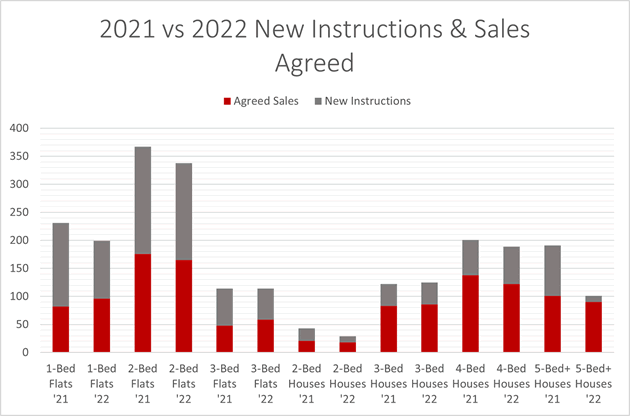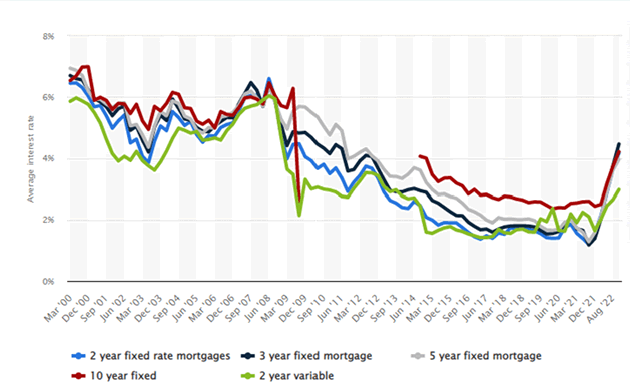Local estate agents Andrew Nunn and Associates 2022 Property Sales review (Ad)

|
2022 Sales Review
They say the property market is never a level playing field and that couldn’t be more true than in 2022.
The year started off with good activity and strong buyer appetite, largely fuelled by the waning of Covid and Bank of England’s rate rise in December of 2021. This increase to 0.25% marked the end of a 21-month run on the all-time low rate of 0.1%, and further rises to 0.5% in February and 0.75% in March reminded buyers to find before being priced out of the market.
As a result, the first quarter of the year – typically one of the quieter of the four as people tighten their belts to compensate for heavier spending over the festive period – was responsible for a strong 26.6% of the sales agreed in the year. The all-too-common shortage of long-term family homes in W4 saw the ‘sealed bidding’ trend that emerged in 2021 continue, strengthening capital value and carrying momentum into the Spring market.
Despite the short-lived hesitancy provoked by Russia’s invasion of Ukraine in February and with March’s budget all but confirming that base rate would continue to rise – as it did by 0.25% both in May and June – to counteract inflation (forecasted at the time to peak in Q4 of 2022 at 8.4%(!)), Q2 remained consistent with the ‘conventional’ seasonality of Chiswick’s housing market. These three months generated 31.8% of the sales agreed in 2022; long-term family homes were still selling within days of marketing to the best bidder, and now flats that had adopted sensible pricing were also increasing in popularity. Furthermore, the incessant imbalance of supply and demand saw more strong capital growth notwithstanding interest rates returning to 1% for the first time since February of 2009. A graph showing Bank of England’s interest rate increases last year.
This sentiment seemed to linger in an unusually hot Q3, both in the property market and the scorching weather! News of Boris Johnson’s resignation early in July, while significant, came as no surprise to many, and was largely overshadowed by rumours that previous inflation forecasts were wide of the mark. Consequently, we were to see the biggest rate rise since February of 1995 – not once, but twice, on the 4th of August and 22nd of September, just sixteen days into Liz Truss’s seven-week cameo in office. Naturally, there was a rush to try and lock in contextually favourable fixed rates prior to these rises, reflected in the fact that 26.1% of the year’s sales were agreed in the summer, despite the usual seasonal distractions of school holidays and warm weather. Truss’s plans of tax cuts and increased borrowing saw the pound take a steeper drop against the dollar. By the close of the quarter, the dollar sat at 1.07 to the pound – down over 20% on its January value. As a result, we saw some reintroduction of foreign buyers who capitalised on excellent conversion rates. With buyer confidence eroding and affordability slashed, activity appeared to drop off as we entered Q4. Rishi Sunak’s appointment as Prime Minister at the end of October saw a reversal of many of his predecessor’s policies and very much confirmed that there would be no shortcuts (or tax cuts!) in the journey out of this recession. Another record-breaking rate rise of 0.75% on the 3rd of November – the most significant since October of 1989 – proved to be the final nail in the coffin, as the nation turned its attention to the festive period and the atypical winter World Cup.

Reports that mortgage rates would begin to settle despite further interest rate rises defused the urgency instilled by previous rate rises, which, together with the lack of available properties on the market, swayed the majority of buyers into deferring their searches until the new year. The top end of the market remained affluent, with some excellent figures being achieved; however, these homes are already few and far between in W4 and hence had little influence on the quarter’s low percentage of sales agreed for the year (15.5%).
2023 Sales Forecast
After the political and economic events late in 2022, it is pleasing that mortgage rates are stabilising and in certain instances are being repriced at slightly lower levels. With 30 years of experience in W4 operating through similar economic cycles, we are well placed to suggest that the market will remain stable, albeit perhaps not with the frenzy of the last couple of years. Historically, property prices have done well under periods of high inflation, and we see this trend continuing going forward thanks to further shortages of property to sell and organically high demand. With this in mind, we envisage 2-3% growth for freehold houses. The challenges in the flat market, such as affordability and the cost-of-living crisis, are more fundamental to buyers’ confidence, and hence the full impact on these will be difficult to quantify until Q2 of 2023. That said, discounted SDLT rates, the strengthening of yields and the resurgence of overseas cash should protect demand for this commodity, thus helping underpin their capital values.
2022 Lettings Review
"Wow…what a year for landlords"
In recent years, we reported on an exodus of tenants from the capital due to the flexible working conditions brought about by the pandemic and associated lockdowns. Towards the end of 2021 we saw many companies re-open their offices and began to notice an increase in employees returning to the workplace, albeit only two or three days a week for the majority. This trend intensified significantly during the course of 2022 as more companies reimplemented normal working practices and there was a growing expectation for employees to give up their work from home habits. Alongside this phenomenon, we have seen a notable increase of enquiries from overseas applicants as travel corridors reopened. For all demographics, it was impossible to escape the negative commentary surrounding the cost of living and, as a result, recalculating expenditure became a priority within the majority of households. We saw an emergence of the importance of EPC ratings as people were battling against rising bills and found many more movers factoring good ratings into their search criteria. Our landlords will be interested to hear the search for accommodation offering the best value for money meant we witnessed an increase in enquiries from central London postcodes that had already priced out a chunk of its residents through growth in already punchy rents. Consequently, demand on the whole increased in 2022 by 50% (Rightmove).

The decline in rental supply over the last 7 years has been well documented and landlords of today are all too familiar with the impact of Brexit, increased taxes, and various legislation changes. Of course, Covid brought about larger void periods and lower rents, all while the government’s 2020/2021 stamp duty holiday appeared to incentivise property sales. To couple this, the anticipation of 2022’s surge in interest rates, sparked by the small yet momentous base rate increase of December 2021, forced landlords to reconsider their portfolios. Hence, last year saw the number of new properties on the market fall by some 25% year on year. The increase of demand combined with the decrease of supply meant that the demand per unit in the last year doubled; our average number of enquiries received per property before going under offer went from 23 to 47! Applicants found themselves competing against an abnormally concentrated pool of movers looking for their new homes. To position themselves, we saw less resistance to longer tenancies, flexible move dates, minimal wish lists, paying rental terms upfront, and it became the norm to offer in excess of the asking price to ensure they could secure a home.
On average, for every ten viewings conducted on a property, six offers would have been received, so landlords could cherry pick the best applicants and rental terms on offer. According to data from Rightmove, average rents in London rose by £325pcm from 2021’s average of £2108pcm - an increase of 16.1%, the highest yearly rate of growth of any region on record. We were delighted that we were able to outperform this figure in 2022 having achieved 20.8% more rent than our 2021 average.
We would like to thank our clients who have supported us in 2022 and we look forward to continue working with you in 2023
2023 Letting Forecast
While we are likely to have already seen the ‘major’ growth in W4 rental values last year, we predict rents will continue to increase, albeit at a more moderate rate, in 2023. Stock levels are unlikely to change as those lost through the introduction of rental reforms, the revised EPC regulations, and the mini budget CGT relief will be offset by some ‘accidental’ landlords and overseas investors capitalising on lower exchange rates. 2023 Lettings Forecast Naturally, affordability will be stretched for all this year and landlords should bear this in mind when choosing tenants who may be pushing their affordability parameters in the hope of being selected. That said, it is unlikely to be of great concern given that demand should remain at the same levels as witnessed last year; hence, landlords will continue to reap all the benefits – no void periods, the best tenants, and top rents. Those re-mortgaging their buy to let properties that have been on 2+ year fixes will notice a drastic change in their repayments, though our anticipated 5% growth in rents in 2023 should help soften this blow.
On paper’ it has never been a better time to be a landlord. If you are considering or are already letting your property and would like to have a more detailed conversation about the market, please do get in touch; we are sure that we can add value.
The Mortgage Market
James Muncaster—Chagnon Financial
So, what a year 2022 was. We started the year with Covid being in the rear view mirror and increases in inflation making the Bank of England sit up and take notice. Mortgage Rates were starting to increase from decade long lows and rates under 2% were becoming a thing of the past. Boris was still PM! Fast forward, 2 Prime Minsters later, a war in Ukraine, the accompanying energy concerns, cost of commodities going up, the Queen, sadly, passing away and inflation in double digits! The biggest mortgage impact was the fall out of the Mini Budget by then Chancellor (we have had 4 of them in 2022!) Kwasi Kwarteng. The financial markets had an extreme reaction and cost of borrowing for the UK “shot up”. The forward predictions for UK Base Rate went from 4% to 6.5-7%. The speed at which this happened, meant lenders pulling rates with no notice, mortgages rates increasing by 0.5% on an almost daily basis and the worry and the concern to the consumer that brought.
As we move into 2023, the new Government has played a calmer hand and the markets have reacted accordingly. Base Rate is still rising but at 3.5% in December, we could be close to the peak of the rates. Tracker Rate Mortgage have gone up in line with this but Fixed Rate mortgages are continuing to reduce.
You’d think after 2022, no one would want to forecast what 2023 has in store but here goes!
1. Base Rate – There is more to go here as inflation is slowing but still over 10%. Do not be surprised if Base Rate is around 4.5%
2. Mortgage Rates – Fixed Rates will continue to reduce from the 5-6% we saw in Autumn 2022. I would not be surprised to see 2 year and 5 year fixed rate being lower than Base Rate. This will be the first time this has happened for 14yrs. We may even see sub 4% rates, as banks look to keep lending volumes high in 2023.
3. Banks – with Mortgage Rates now expected to be higher, the banks and building societies are going to have to work harder for their business. This could lead to a price war amongst the main players. I expect there will also be movement on lending policy.

The Bank of England removed the 3% Stress Test recommendation in August 2022. This means that banks do not need to add 3% to their Variable Rate to see if a client can still afford the mortgage payments. With Variable Rates now 6%+ in most cases, this could be an area that frees up some lending ability for a client. Other lenders may just look to increase income multiples. Already, there are a number that can go beyond 5 times income for higher income earners, so this could be another route. Another area that the banks will look at is technology and automation. Most lenders suffered badly with service in 2022. This was to such an extent that some lenders had to switch their lines off and work on a call back basis! My team were used to hold times of 2hrs plus! Banks will look to technology to keep the same level of business coming in but without the same level of contact per application. This will reward those mortgage brokers who present their applications correctly and make sure to ask clients for the right information. We could then see an increase of mortgage offers within 1 week. Overall, my view of 2023 is a positive one. There will be opportunity with property prices and my focus, with my clients, will be on the perception of the cost of a mortgage. Planning and understanding what you can do with the structure of a mortgage to fit your budgetary needs, will play a big part in 2023. There will be more need to think through the mortgage options and get the correct advice on the right path forward. Let us hope it is a more straightforward year than 2022!
Advertorial
January 10, 2023

